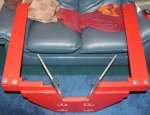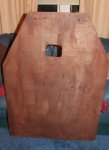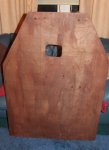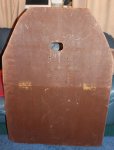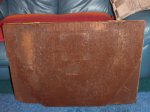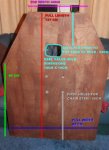"The leak did cause me to regret the original use of OSB for my flooring material...never dried out, absorbed a bunch of water and nearly doubled in thickness..thus increasing the weight considerably..So I have been there done that badge of honor also!!!LOL"
Yes I believe it is a very unique pain we share, one that few others can ever comprehend.
As regards the maintenance hell that is repairs using solvents.
I grew tired of using PVC solvents that claimed to end my misery of puddles at my ankles. Some would last one or two trips but I always ended up where I started, wet and miserable. In fact if I were out for twelve hours on a long summer day I'd have to set aside an hour half to empty the boat of gear and tip the boat to get all the water out. So I decided to experiment.
I took one of the inflatable pillows that came with the boat which use the same material as the hull, and dissected it into a variety of patches I might need in the future. Then using a batch of small patches I smeared each in different types of solvent, folded them over, let them dry then left them in glasses of water to gauge their effectiveness. I lost count of how many different types of solvent I bought from my local hardware store, some of them costing £10 ($14) for a small tube.
What eventually worked perfectly was the one glue I had been avoiding for fear of destroying the boat. Superglue.
I've been out a dozen times on my superglue patch and it's still solid, but here's the catch. Are all superglues identical? I'm not so sure. Having found a brand that works I would never try another on the boat without first testing it on a patch. Having established a superglue that worked I bought a bunch of that specific brand for future events. (In this case it's cheap generic superglue from my local Asda superstore.) If it works, hoard it, is my motto.
But on the subject of the floor. In my opinion the floor membrane and the seam attaching it to the boat hull are the Mariner's greatest weakness. In particular the rear half of the floor where most of the weight is usually sitting. I've highlighted this pic so people know what I'm talking about.

I fish with my Mariner in the glacial lochs of Scotland, which usually means stones, millions of them. From the start I would use a tarp for setting up the boat before dragging it into the water proper.
But I soon realised the weight at the rear when coming back ashore was creating tiny pin prick holes in the membrane. And while they won't bring too much water in, it does highlight the weakness of the material. So much so I considered buying a roll of grey PVC and covering the membrane at the rear half, either side of the keel's rock-guard strip.
However I had doubts about whether or not I could glue such large sections of PVC securely without them coming off when the boat was going through the water. In the end I came up with better methods for getting the boat in and out the water to avoid stones causing problems. I repaired the holes I had using transparent bike repair patches placed on the inside of the membrane and they work fine.
I saw someone asking earlier what was the best method for finding holes. In my experience, if it's an air hole, coat one section of the boat at a time in very soapy water and it should reveal the leak. It helps if you have someone occasionally pumping air into the section to maintain pressure until leak is found.
If it's a water leak relating to the floor membrane or floor seam, try this.
Fully inflate the boat in darkness either inside the house or in the yard. Flip the boat and climb underneath. Have someone on the outside use a very powerful torch to highlight the membrane and seal while you push the membrane up and away from you. Work your way slowly section by section to give each section the all clear.
If there are any holes in the membrane they will light up and look like stars in the night sky. Use a marker pen to circle them for patching later using transparent bike tube patches.
If there are any weaknesses in the seal, they will show up as brighter sections where it's been stressed. Mark those areas on the outside, taking care to outline the length of the problem. Do this even if you see no actual holes. If the section is brighter it's stressed and will likely open once full weight is applied to hull when boat is in use. Then apply a patch at least two inches wide and as long as the highlighted area. I even considered doing this the entire length of the seam to prevent future problems.
Best way to apply a patch? You'll need your solvent of choice, a patch, a heavy weight and a Beanie Baby. Yeah, I finally found a use for Beanie Babies. Apply solvent to patch and area to be patched. Once tacky press patch on, ensuring there are no air bubbles etc. Wipe away excess solvent from the edges then lay Beanie baby on patch. Then put heavy weight on the Beanie. The Beanie's tiny beaded innards will spread the weight out evenly over the patch to ensure a good seal. Leave for at least a couple of hours, or twenty mins if using a superglue you know to be safe.
Over time sand and grit will build up along the seams and under the inflatable keel, so giving your boat a good hosing or pressure wash around the inside seams now and again is a good idea.























